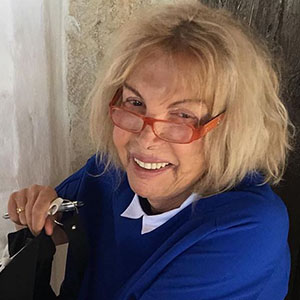
Chloe Kolyri
Country: Greece
Organization: private practice
Short CV
Chloe Kolyri, MD, Phd. Psychiatrist-psychoanalyst, Queering psychoanalyst. Politics of psychoanalysis. Moderator of the Greek Society for Deleuze and Guattari Studies, Co-founder of the Greek Anti-psychiatry group.
Short presentation
(together with: Vassiliki Roussou)
Title: The ‘rhizome’ as the/a model of experiencing psychotherapy
Humans are becoming entities throughout different times in their lifetime. Their potentials (existentialia) are constantly being experienced as parts of the polymorphous world to which they belong. This is because their affectivity finds its way not only through conscious attention or via analyses based on a metaphysics of presence, but mainly through our attunement with the music of the World, which permeates every molecule in all entities and milieu. The attunement of our being-in-the-world, as Svenaeus (2000) suggests, seems to be the very phenomenon we need to attend to, when trying to grasp the difference between healthy and ill ways of being-in-the-world. To be healthy or ill is certainly not the same as having a good or a bad feeling. Attunement is not the quality of a thing – of an isolated human subject – but rather, a being delivered to the world, a finding of oneself in the meaning-structure of the world as an understanding existence.
In this presentation, we draw upon the term rhizome, a term originating from the Ancient Greek word ρίζωμα, which means “mass of roots”. The rhizome is generally defined as an interaction system applied to any division that follows no specific pattern or rules of organization; but as a philosophical term, it gained prominence through the work of G. Deleuze and F. Guattari (1987), who employed it in order to describe an a-linear (i.e., a nonlinear) network that “connects any point to any other point” (p.21). This multiple, spread out, all proliferating and without boundaries, centres/margins or limits perspective is aspiring to describe the relations and connectivity of things during therapy. The rhizome is like a map, a network of multiplicities. We refer to this notion, then, as a concept capable of offering us a more radical understanding of the ontological processes taking place in dynamic and mutating assemblages.
To this extent, what we do in therapy is welcoming all parts of the fragmented self, allowing them to consonate or dissonate according to the refrains of freedom chanted by the world. Both the client and the therapist must abandon all pre-given and predefined identities, and opt for difference in itself. The body must be considered and respected both as an organism and as what D & G call a body without organs (i.e., “the unformed, unorganized, nonstratified, or destratified body and all its flows”; Deleuze and Guattari, 1987: p.43). Nobody knows “what a body can do” if it is restrained and subordinated to intellect. The body is a rhizome of connections that is always open to new conjunctions and disjunctions. The novel ways we find to hear and speak are nothing less than a re-education in the most fundamental of senses, for what they are effectively doing is generating new real-world relations. To illustrate some of these novel ways, the presentation will be enriched with clinical cases.
References (available upon request)
Deleuze, G. and Guattari, F., 1987. Capitalism and schizophrenia: A thousand plateaus. Trans. Brian Massumi. Minneapolis: University of Minnesota Press.
Svenaeus, F. 2000. The body uncanny — Further steps towards a phenomenology of illness. Medicine, Health Care and Philosophy 3, 125–137.
Round-table discussion
(together with: Anna Apergi-Konstantinidi & Parvy Palmou & George Kesisoglou & Pavlos Zarogiannis)
Title: Gender, identity, and sexuality as multiplicities: heteroglossia and polyphony
It seems that, in recent years, what Aristotle once formulated is increasingly accepted, namely that “it seems impossible for all things to be one” and that ultimately the “one… is many”. This notion seems almost self-evident, if one considers, even for a moment, the diversity of all living beings, humans included. It is a notion that could lead to a horizontal distribution, mutual recognition, and equal acceptance of all living beings.
And yet: the one may be many, but the many were sacrificed, and continue to be sacrificed, in the name of the one. Because what has prevailed and what has been imposed for centuries is categorization, grouping, and homogenization, as well as the vertical hierarchy of homogenized categories and groups, something that led, and still leads, to prohibitions, marginalization, exclusions, and conditional inclusions with painful, traumatic, and sometimes tragic consequences for those who belong to the arbitrarily and pejoratively called “minority” groups.
Maybe now is the time to remember Aristotle’s saying about the multiplicity of beings and to reflect on their heteroglossia and polyphony. And, of course, it is also a time for us to contemplate the depth and implications of this saying at all levels of our psychotherapeutic practice. And this not only in relation to our patients, but also to us as therapists.

